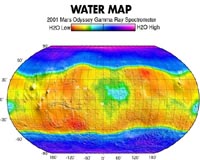 |
Providence RI (SPX) Jun 25, 2010 Planetary scientists have uncovered telltale signs of water on Mars - frozen and liquid - in the earliest period of the Red Planet's history. A new claim, made public this month, is that a deep ocean covered some of the northern latitudes. But the evidence for water grows much more scant after the Noachian era, which ended 3.5 billion years ago. Now Brown University planetary geologists have documented running water that sprang from glaciers throughout the Martian middle latitudes as recently as the Amazonian epoch, several hundred million years ago. These glaciofluvial valleys were, in essence, tributaries of water created when enough sunlight reached the glaciers to melt a thin layer on the surface. This, the Brown researchers write, led to "limited surface melting" that formed channels that ran for several kilometers and could be more than 150 feet wide. The finding is "more than 'Yes, we found water,'" said Caleb Fassett, postdoctoral research associate in geological sciences and lead author of the paper published in Icarus. "What we see now is there's this complex history of different environments where water is being formed." Fassett, with Brown research analyst James Dickson, professor James Head III, and geologists from Boston University and Portland State University, analyzed 15,000 images snapped by the Context Camera (CTX) aboard the Mars Reconnaissance Orbiter to compile the first survey of glaciofluvial valleys on Mars. The survey was sparked by a glaciofluvial valley that Dickson, Fassett, and Head spotted within the Lyot crater, located in the planet's middle latitudes. The team, in a paper last year in Geophysical Research Letters, dated that meltwater-inspired feature to the Amazonian. In his survey, Fassett found dozens of other Amazonian-era ice deposits that spawned supraglacial and proglacial valleys, most of them located on the interior and exterior of craters in Mars' midlatitude belt. "The youthfulness (of the features) is surprising," he said. "We think of [post-Noachian] Mars as really, really cold and really, really dry, so the fact that these exist, in those kinds of conditions, is changing how we view the history of water on the planet." What makes the finding even more intriguing is that the Brown planetary scientists can study what they believe are similar conditions on Earth. Teams from Brown and Boston University have visited the Antarctic Dry Valleys for years, where the surfaces of glaciers melt during the austral summer, sparking enough meltwater to carve a channel. The team will return to the Dry Valleys later this year to continue the study of this microclimate. "It's sort of crazy," said Dickson, a member of the Brown team who stayed in the Dry Valleys for three months last year. "You're freezing cold and there's glacial ice everywhere, and it gets just warm enough that you get a river." Fassett plans to search for more glaciofluvial valleys as more images come from the CTX, which has mapped roughly 40 percent of the planet. Contributing authors include Joseph Levy of Portland State (who earned his Ph.D. at Brown last year) and James Marchant of Boston University. The research was funded by NASA.
Share This Article With Planet Earth
Related Links Brown University Mars News and Information at MarsDaily.com Lunar Dreams and more
 A third of Mars once covered by ocean: study
A third of Mars once covered by ocean: studyParis (AFP) June 13, 2010 A huge, potentially life-giving sea likely covered more than a third of Mars some 3.5 billion years ago, according to a study released Sunday. Spread over an area the size of the Atlantic Ocean, it would have straddled the north pole and contained the equivalent of a tenth of the water on Earth. For decades scientists have argued as to whether the Red Planet once harboured bodies of wate ... read more |
|
| The content herein, unless otherwise known to be public domain, are Copyright 1995-2010 - SpaceDaily. AFP and UPI Wire Stories are copyright Agence France-Presse and United Press International. ESA Portal Reports are copyright European Space Agency. All NASA sourced material is public domain. Additional copyrights may apply in whole or part to other bona fide parties. Advertising does not imply endorsement,agreement or approval of any opinions, statements or information provided by SpaceDaily on any Web page published or hosted by SpaceDaily. Privacy Statement |